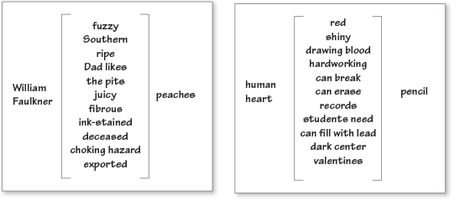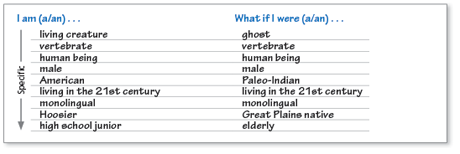Web page: Thinking Metaphorically
Web page: NY Times, This Is Your Brain on Metaphors
PDF: Excerpt of The Way We Think: Conceptual Blending and the Mind's Hidden Complexities
When you understand an idea, you know what it means, why it is important, and how it fits with other ideas. Creative thinking can help you understand an idea by connecting it to others.
Metaphorical thinking connects two different ideas to show how they are similar. One way to learn something new is to associate it with something you already know. The fit will not be exact, but that mismatch creates the possibility to discover new connections. Here are four types of metaphorical thinking:
SimileCompare two things using like or as. |
An electron is like an energetic kid running around her parents. |
MetaphorCompare two things by equating them. |
The proton and neutron are the parents in the atom. |
AnalogyCompare two relationships. |
Compare the force that binds a nucleus to the marriage that binds a couple. |
SymbolUse one thing to represent another. |
Let’s represent this force with a marriage certificate. |
Your Turn Choose a topic that you are currently studying. Then associate that topic with familiar ideas, creating a simile, a metaphor, an analogy, and a symbol.
Conceptual blending, which connects two unrelated systems or organizations, is another type of metaphorical thinking. Create conceptual blends by forcing two concepts together and trying to work out the conflicts between them.
Your Turn Choose something you are currently studying—a concept, an organization, an idea—and then think of something entirely different. Construct a question creating a conceptual blend. Then answer the question as creatively as you can.
Creative thinking discovers connections that no one else has noticed. You can force connections by writing down two dissimilar things and writing as many connections as you can between them.

Creating forced connections between two subjects deepens your understanding of each subject.
Your Turn Select a topic you are currently studying. Choose something else completely unrelated to it. Write down the two topics and list as many connections as you can between them.
Creative thinking discovers unique ways to look at something. Start by identifying your perspective, from very broad to very specific. Then change one or more aspects of the perspective and think about the topic again.

By intentionally shifting out of your typical perspective, you can discover all-new ways of thinking.
Your Turn Write “I am (a/an) . . .” and list key traits about yourself, from broad to specific. Then write “What if I were (a/an) . . .” and change some of the things on your list. Then think about a topic from your new perspective.
Web page: Thinking Metaphorically
Web page: NY Times, This Is Your Brain on Metaphors
PDF: Excerpt of The Way We Think: Conceptual Blending and the Mind's Hidden Complexities
Web page: Serious Creativity, Forced Connections
Web page: Brainstorm Technique #5 – Forced Connections
Web page: Perspective Shifting: An Effective Strategy for Anger Managment
© 2014 Thoughtful Learning
